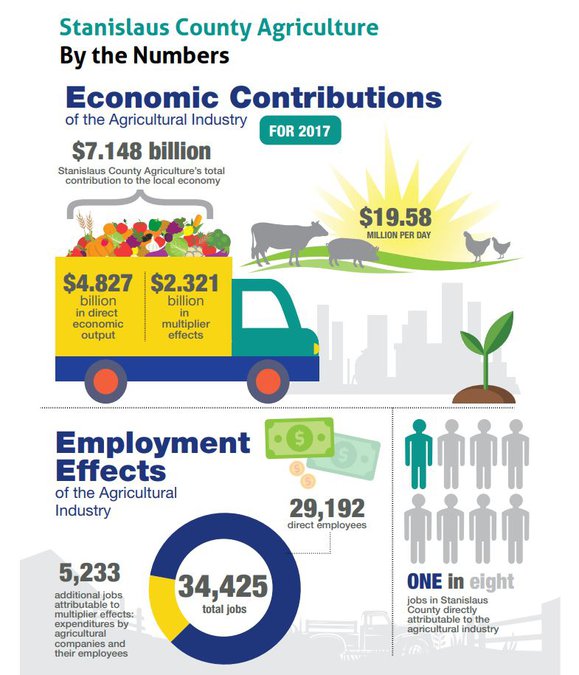Almonds have consistently ranked number one on Stanislaus County’s list of top-valued commodities since 2013, and the 2018 Agricultural Report released this week shows no sign of the industry slowing down. While highlighting the county’s booming crops is one goal of the report, however, this year’s analysis of the area’s agriculture also takes a look at the small pollinators that make its economic impact possible: bees.
“At $1.1 billion, almonds are a driving force in the county economy. We owe much of this prosperity to a modest but industrious insect, the honeybee,” said Amy Lomeli of the agricultural commissioner’s office, who pointed out to the Board of Supervisors during their meeting on Tuesday that bee deaths have dramatically increased over the last 20 years.
Honeybees contributed to an agriculture economy that produced $3,569,999,000 in 2018 — a decrease of $78 million, or about two percent, from the 2017 value of $3,648,192,000. While some commodities, like almonds and poultry, retained or increased their value, those gains were offset by decreases in walnut values, fewer nursery products sold, continuing decreases in national milk prices and the county’s own fluctuation of turkey production.
California produces two-thirds of the United States’ fruits and nuts and a third of the country’s vegetables. While not all these commodities rely exclusively upon bees for pollination, Lomeli pointed out that a significant proportion — such as almonds — experience essential increases in production with the presence of bees, and the report states we would be “remiss to deny their vital role in bringing food to our tables.”
“Although over 230 different commodities are produced in Stanislaus County, the top 10 commodities alone represent 80 percent of the county’s total production value,” Lomeli said. “When combined with all other commodities produced in our county, Stan County’s agricultural value ranks higher than 20 different states’ agricultural values and is the fifth-largest agricultural county in the nation based on commodity values.”
Coming in at number one on the report’s list of top 10 commodities, almonds accounted for 30 percent of the county’s total commodity value at $1,107,328,000 in 2018, with the commodity’s value increasing by $51 million since 2017. This was largely due to an additional 8,500 harvested acres in 2018.
Poultry also remained a strong industry in Stanislaus County, valued at $276,879,000 in 2018 and ranking third on the top commodity list. This was an increase of over $20 million from 2017, resulting from an increase of about two million chicks countywide and price increases for both chicks and chickens.
Despite an increase of 850 walnut orchard acres in 2018, the commodity ranked seventh on the county’s list with a value of $103 million. This represents a decrease of $61 million from 2017.
“Walnuts had an increase of 850 acres, but it was the decrease in price of $913 per ton which caused this category to have a large value drop,” said Richard Homer of the agricultural commissioner’s office.
The turkey market in Stanislaus County also saw a significant drop, coming in at ninth on the list after losing $20 million in value since 2017. The sale of nursery fruit and nut trees as well as vines decreased by $56 million, with nine million fewer units sold in 2018 than 2017, according to Homer. Milk also continued to struggle in Stanislaus County despite ranking as the second top-producing commodity, falling in value by nearly $30 million.
Almond pollination is a commodity on the rise, ranking eighth on the top 10 and valued at $75,847,000 — an increase of about $8 million. Lomeli explained the steps Stanislaus County is taking to ensure the safety of honeybees, utilizing programs like BeeSafe, which provides guidance in proper identification of hives to help prevent apiary theft, inspections for colony health and pest pressure, and identifying and increasing good foraging areas within the county.
“We know that apiary health and wellness is directly tied to the prosperity of Stanislaus County and California agriculture, and hope that everyone will keep in mind the humble honeybee’s role while reviewing this report,” Lomeli said.
To view the Stanislaus County Agricultural Report of 2018 in its entirety, visit www.stanag.org.





